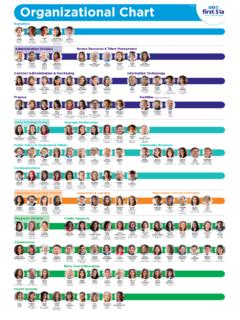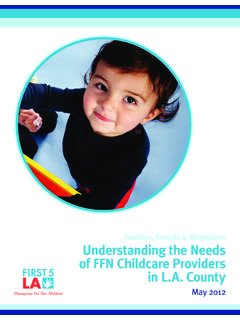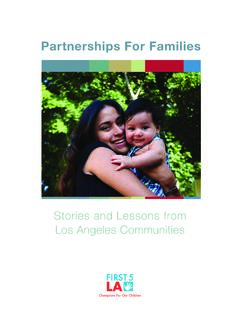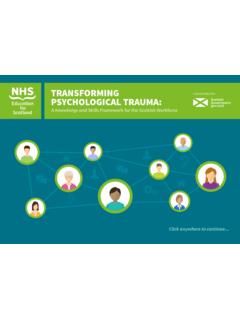Transcription of TRAUMA AND ESILIENCY A SYSTEMS CHANGE …
1 TRAUMA AND RESILIENCY: A SYSTEMS CHANGE approach . Emerging Lessons and Potential Strategies from the Los Angeles County TRAUMA and Resiliency- informed SYSTEMS CHANGE Initiative July 2017. Funded by The California Community Foundation The California Endowment First 5 LA . The Conrad N. Hilton Foundation The Ralph M. Parsons Foundation Written by John G. Ott, Rose A. Pinard, Ken Ithiphol Trevor Thomas Olwig Center for Collective Wisdom T ABLE OF C ONTENTS. Executive Summary .. ii Appreciations .. xi Introduction .. 1. Section 1: Why This Matters .. 3. Why focus on TRAUMA .. 3. Defining TRAUMA and resiliency .. 5. Section 2: Lessons Learned .. 9. An abiding why tied to results .. 9. A sustained focus on long-term culture CHANGE .. 12. An ongoing yes to participatory engagement .. 15. Cultivating a learning culture .. 16. The complexity of community.
2 18. Section 3: A Developmental Framework .. 23. Definitions .. 24. Guiding principles .. 25. Implementation domains .. 26. Developmental stages: An overview .. 30. Developmental stages: Definitions Descriptions Resources .. 32. Section 4: Potential Strategies .. 41. Strategy to deepen CHANGE within particular SYSTEMS .. 42. Cross- system strategies .. 43. Strategies to build public awareness .. 45. Building the capacity to hold the whole .. 46. Conclusion: Why Now?.. 49. Attachments .. 51. Attachment A: Summaries of SYSTEMS CHANGE Initiatives .. 52. Attachment B: Sample Resources to Support SYSTEMS CHANGE Initiatives .. 105. Attachment C: Participants Engaged in the Process to Date .. 155. Center for Collective Wisdom Page i E XECUTIVE S UMMARY. Over the past nine months, the Center for Collective Wisdom has worked with five funders and a broad group of stakeholders to explore the potential for nurturing and deepening SYSTEMS CHANGE efforts in Los Angeles County focused on TRAUMA and resiliency.
3 During this time, we have also researched relevant system CHANGE efforts from across the country, analyzed a wide range of resources related to TRAUMA and resiliency, and engaged in conversations with senior leaders and others from SYSTEMS across the county to gauge resonance and readiness for SYSTEMS -level CHANGE to address TRAUMA and promote resiliency. This report summarizes the results of these dialogues and research, including lessons learned, a developmental framework to guide SYSTEMS CHANGE efforts, and potential strategies for advancing this movement across the county. WHY THIS MATTERS. Among the many historical influences that have given rise to a movement focused on TRAUMA and resiliency, the 1998 Adverse Childhood Experiences (ACE) study1 has been particularly significant in building a broader conversation about TRAUMA and the need to more systematically address its negative effects.
4 This study examined the impact on health and wellbeing across a person's life from childhood abuse, neglect and other adverse experiences, including: physical, sexual, or emotional abuse; physical or emotional neglect; a family member who is: depressed or diagnosed with other mental illness, addicted to alcohol or another substance, or in prison; witnessing a mother being abused; and losing a parent to separation, divorce, or other reason. The import of this study was not simply the high prevalence of ACEs documented among the 17,000 predominantly white, older, college educated participants, all of whom had health insurance and had received physical The study unexpectedly revealed a significant correlation: the higher the number of ACEs, the higher the risk for a wide range of negative health outcomes. A more recent report by the Center for Youth Wellness applied the ACEs framework to California residents,2 and compared the negative health outcomes for people with 4 or more ACEs to people with zero ACEs.
5 The report found that, compared to adults with zero ACEs, Californian adults with 4 or more ACEs are: times as likely to attempt suicide;. times as likely to use injection drugs;. times as likely to be an alcoholic;. times as likely to have ischemic heart disease; 1 Centers for Disease Control and Prevention. < >. 2 Center for Youth Wellness. A Hidden Crisis: Findings on Adverse Childhood Experiences in California. San Francisco, CA: 2014, p. 6. < >. Note: The data in this report on California residents was collected through the Behavioral Risk Factor Surveillance system , an annual, state-based, random-digit-dial telephone survey. The summary is a cumulative analysis of all four years of ACEs data (sample size = 27,745). Center for Collective Wisdom Page ii TRAUMA and Resiliency: A SYSTEMS CHANGE approach July 2017. Executive Summary times as likely to have cancer.
6 Times as likely to report one or more days of poor physical health in the past 30 days;. Almost 2 times as likely to report poor mental health in the past month; and times as likely to report that their poor health physical or mental had prevented them from participating in their usual The report authors observe: There is a hidden danger lurking in communities across California. Adverse Childhood Experiences, or ACEs, affect people from all backgrounds, regardless of race, income, education, or geography. Occurring in childhood, exposure to chronic adversity during the most formative years of a person's development has the potential to reap a lifetime of challenges, including poor health and even early As compelling as the ACEs research is, however, it actually understates the impact of TRAUMA on the health and wellbeing of individuals, families, and communities.
7 The reason is straightforward: there are far more sources of TRAUMA , for children and adults, than the original ten ACEs, including: Physical, psychological, and sexual abuse experienced after childhood;. Community violence;. Homelessness;. Natural disasters;. Refugee and war zone TRAUMA ;. Terrorism;. Oppression, including structural oppression; and Multi-generational or historical TRAUMA . DEFINING TRAUMA AND RESILIENCY. In our research we discovered numerous definitions of TRAUMA . Building on the work of the Substance Abuse and Mental Health Services Administration (SAMHSA)5 and incorporating reflections and feedback from workgroup participants, we ultimately defined TRAUMA as follows: The term TRAUMA refers to the effects of a single event, a series of events, and/or ongoing circumstances that are experienced or perceived as physically or emotionally harmful and/or life threatening.
8 TRAUMA can affect individuals, families, and communities immediately and over time, even generations. The adverse effects of TRAUMA can be profound and long-lasting, resulting in diminished functioning and wellbeing, including mental, physical, social, emotional, and/or spiritual wellbeing. 3 Ibid., pp. 2, 11. 4 Ibid., p. 1. 5 Substance Abuse and Mental Health Services Administration. SAMHSA's Concept of TRAUMA and Guidance for a TRAUMA - informed approach . HHS Publication No. (SMA) 14-4884. Rockville, MD: Substance Abuse and Mental Health Services Administration, 2014. < >. Center for Collective Wisdom Page iii TRAUMA and Resiliency: A SYSTEMS CHANGE approach July 2017. Executive Summary Regardless of the precise definition of TRAUMA , however, the research and work on ACEs, complex TRAUMA , toxic stress, and community TRAUMA invite a profound shift in perspective and behavior in organizations and SYSTEMS dedicated to promoting wellbeing among children, adults, families, and communities.
9 This shift begins with a renewed commitment to curiosity and empathy for another person's life experiences. Instead of seeing a person's behavior as the root problem, we are invited instead to see behavior both as symptom and communication. Rather than asking What's wrong with you?' we ask What happened to you?' 6. And yet, as impactful as this research has been, a potential unintended consequence is that it can reinforce a (mis)perception that nothing can be done once someone has experienced adverse childhood experiences or other experiences leading to severe TRAUMA . This is why any conversation about TRAUMA should be linked to a conversation about resiliency, which we defined as follows: The term resiliency refers to the capacity of individuals, families, and communities to heal from TRAUMA , and to strengthen their wellbeing and adaptability in ways that can mitigate or prevent future TRAUMA .
10 As organizations and SYSTEMS become more adept at assessing for, recognizing the symptoms of, and addressing TRAUMA , they must become equally adept at helping individuals, families, and communities strengthen their resiliency. This call to promote resiliency is not merely rhetorical, nor is this work a substitute for the work to understand and address the root causes of TRAUMA . Working to strengthen the capacity of individuals, families, and communities to heal and adapt in the face of profound adverse circumstances requires discipline and persistence, as does the equally challenging and essential work of reducing and, where possible, eradicating sources of TRAUMA . Our call, therefore, is for a commitment within organizations and SYSTEMS to help individuals, families, and communities both heal from TRAUMA and strengthen their resiliency, to become TRAUMA and resiliency- informed .





